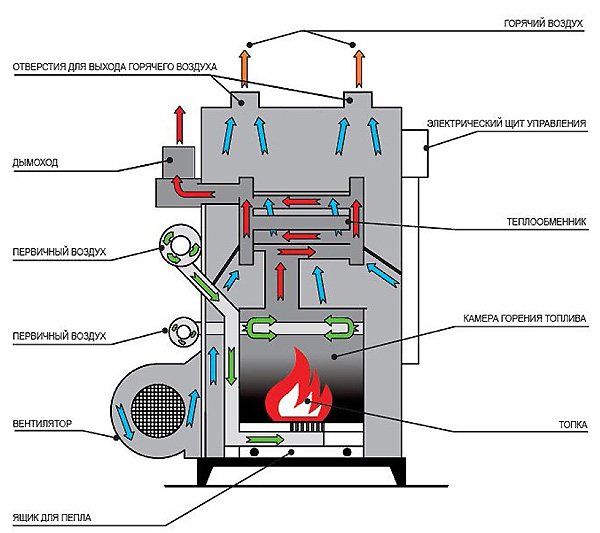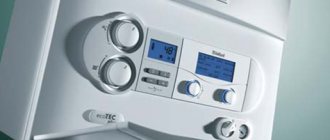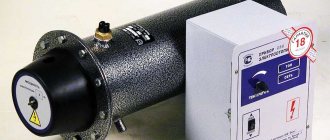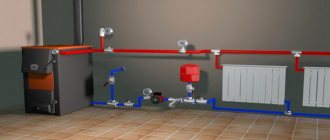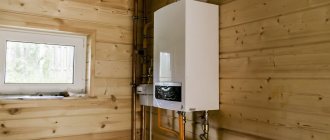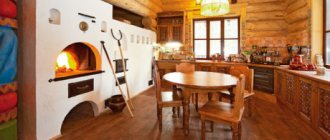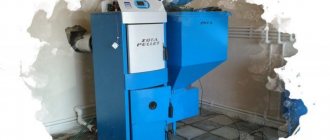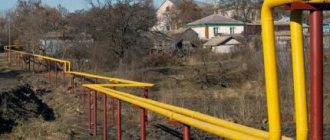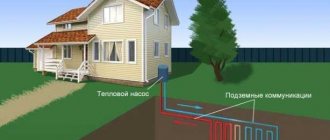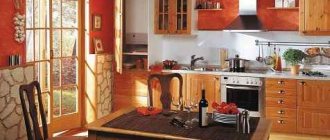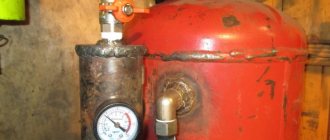Basic parameters of solid fuel boilers and stoves
Solid fuel heat supply is characterized by relatively low initial costs. There are affordable solid fuel home heating boilers on the market. However, the process of installing equipment and the entire system as a whole must be carried out according to certain rules.
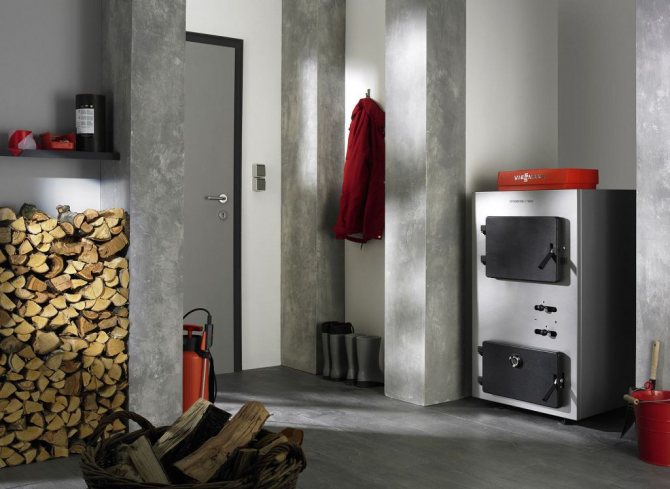
Solid fuel boiler in the heating system
Almost all solid fuel stoves and boilers for hot water heating have the same characteristics. Their knowledge and ability to use information correctly will help you choose the right equipment for heating your home. When choosing, you should pay attention not only to technical aspects, but also to workmanship. Home heating boilers for solid fuels must be made of special grades of steel. The case is at least 2 mm thick. For the combustion chamber, heat-resistant steel with a thickness of 3 mm or more is used.
The advantage will be a guarantee from the manufacturer and seller of heating equipment. You also need to pay attention to the presence of a network of service centers for maintenance and repair. In order for reviews of solid fuel heating boilers to be only positive, when choosing equipment, you should study the following parameters:
- Rated power. It is determined by preliminary calculations of heat supply. To form a small stock, heating a private house with solid fuel must have a capacity of 15-20% more than the calculated one;
- Heat exchanger material... The most reliable are cast iron solid fuel heating boilers. Their disadvantage is a large indicator of inertness and possible destruction under strong mechanical stress. The alternative are lighter and cheaper models with a steel heat exchanger;
- Boiler type. In addition to classic direct combustion equipment, you can choose pyrolysis or long-burning boilers.
Do-it-yourself solid fuel heating boilers are often made. But to do this work, you need to choose the right manufacturing scheme and materials. The advantage of such designs is the ability to adapt according to the above parameters to a specific heating system.
All solid fuel air heating stoves are designed to use coal, wood, fuel briquettes or peat. Exceptions are pellet boilers, which differ in design and are intended only for pellets.
Organization of the water circuit for heating
Materials used for pipes
Steel
Steel is used for pipes for solid fuel heating of a private house, based on natural circulation.
Such pipes are the cheapest and, at the same time, they are not threatened by rapid corrosion, since during prolonged circulation of the coolant, oxygen quickly evaporates from it.
Galvanized
Galvanized pipes are made from zinc coated steel. They have the same characteristics as regular "black" ones, but look more aesthetically pleasing. In addition, they are more durable thanks to the additional coating.
Copper
Copper is a more expensive pipe material that is well suited for autonomous heating systems with circulation pumps or wall-mounted boilers.
Copper does not corrode like steel, which means it does not face clogging, which is especially threatening such systems.
Which system is better
In the heating of private houses, two circulation systems are used to supply the coolant:
- Natural
- Using a circulation pump
In the first case, water is supplied through pipes due to the difference in temperature and mass by gravity.It is suitable for small houses as it is cheap enough and does not require additional electricity consumption
At the same time, the installation of a pump ensures more efficient circulation of the coolant in large or multi-storey buildings. The main disadvantage is that the circulation pump is dependent on a stable connection to the mains.
Solid fuel heating schemes
The installation of heating equipment is preceded by the choice of a scheme. The complete set of heat supply, the parameters of the system's operation, as well as the type of coolant depend on it. In some cases, a solid fuel steam heating scheme is advisable. But most often they choose water heating at home.
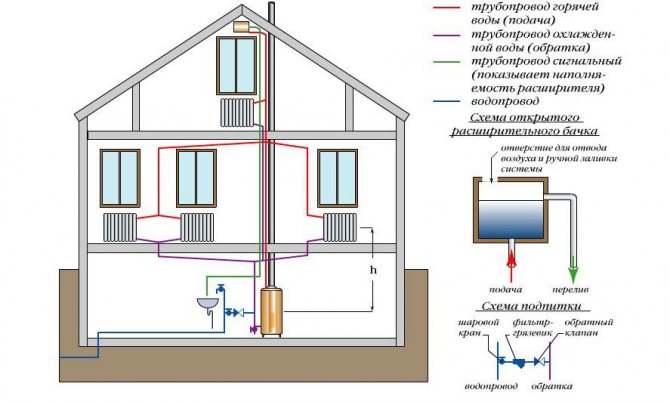

House water heating scheme
The choice is determined by the characteristics of the house - its area, heat losses and the required temperature mode of heating. For uniform heat distribution, a scheme for installing a solid fuel heating boiler in a water circuit is recommended. If the area of the house is small, air heating can be used. In rare cases, home-made steam boilers for solid fuel heating are used.
At the first stage of choosing a scheme for installing a solid fuel heating boiler, it is difficult to determine the type of heat supply. Currently, the most common types are the following:
- Water with natural circulation... Applicable for small private houses and summer cottages. This is due to the maximum possible length of the line up to 30 m. Even with a powerful heating boiler for a house on solid fuel, the water circulation rate will be small;
- Forced circulation water... For this type of heat supply, you can think of the manufacture of a solid fuel heating boiler with a built-in pump. Thanks to this design, the heating area is significantly increased;
- Air... It can be realized with the help of special do-it-yourself solid fuel heating boilers, which have channels for the circulation of warm air in the design. An alternative is to install an air heat exchanger and a duct system to distribute heated air to the rooms of the house;
- Steam... It is used extremely rarely in autonomous heating due to the high cost of equipment and the need for constant monitoring of the state of the coolant. Most solid fuel steam heating schemes are designed to heat large buildings.
The best option for installing a home solid fuel heating boiler is water heat supply with forced circulation. It has good performance and is inexpensive to maintain. You can also note a large number of schemes, according to which you can independently calculate a solid fuel heating boiler.
In any heating system, regardless of the chosen scheme, safety elements must be present. For solid fuel boilers for hot water heating, these are air vents, drain and check valves.
Rules for air heating
Heating with warm air, like any other type of heating, should provide comfortable conditions for living in the house. According to regulatory documents, in residential premises, the minimum temperature should not fall below 20 ℃, if the room is corner - not lower than 22 ℃, in the kitchen and toilet - at least 18 ℃, and in the bathroom should be at least 25 ℃. These general rules apply to both private houses and apartments in multi-storey buildings.
Air heating must provide high-quality heating in order to neutralize heat loss through walls, roofs or ventilation systems. Therefore, it is important to correctly calculate the power of the air heating boiler. It is impossible to accurately determine the level of heat loss, since this indicator is influenced by many factors.
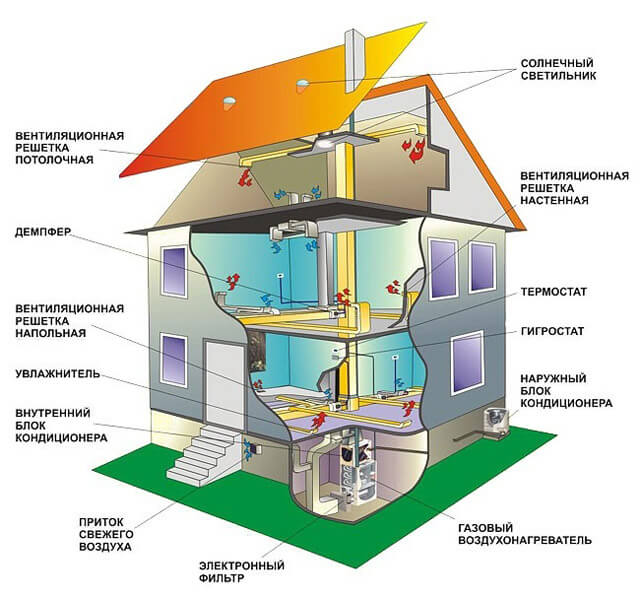

An approximate calculation of the power of an air heating boiler can be performed using a special technique.For each 1 m 3 of the volume of the room, 40 W of power is included in the calculation. To the total amount you need to add 100 W for each window, 200 W for the front door if it leads to the street. In addition, special coefficients are taken into account: 1.2-1.3 for corner apartments and 1.5 for private houses.
Heat loss also depends on the geographical location of the housing. So, for houses in the southern regions, the coefficient is 0.7-0.9; for central regions - 1.2-1.3; for the Far East and the Far North - 1.5-2.0. In order to make it more convenient to regulate the temperature in the room, you can install chokes or a thermostatic head on the radiators.
Direct fired boilers
The simplest solid fuel heating boiler device has classic models. They consist of a combustion chamber, ash pan, heat exchanger and chimney. The transfer of thermal energy to water occurs due to the combustion of fuel in the furnace.
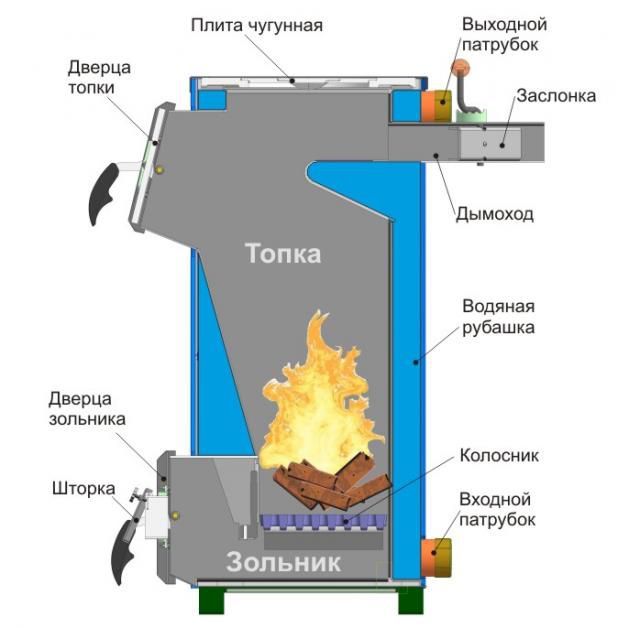

Direct combustion boiler design
The advantage of such models is reliability and simplicity of design. For the independent manufacture of a solid fuel heating boiler of this type, a minimum of tools and materials will be needed.
But along with the positive qualities, these boilers have a number of disadvantages. The main one is high fuel consumption. In reviews of direct combustion solid fuel heating boilers, they indicate the need for the constant addition of firewood or coal. If this is not done, the temperature of the water in the pipes will inevitably decrease.
It should also be noted such features of heating a private house with solid fuel using boilers of this type:
- Large indicator of inertia... The time for heating water in pipes to the required temperature can be from 10 to 30 minutes, depending on the type of system and its characteristics;
- Power regulation problems... As in solid fuel air heating stoves, this can only be done by restricting the air flow through the ash pan. Therefore, when designing a heat supply system, it is necessary to provide for the installation of safety devices;
- Low efficiency rate... Usually it is around 60-65%. This is due to the fact that some of the thermal energy leaves with carbon monoxide through the chimney;
- Equipment... The composition of steel and cast iron boilers for solid fuel heating does not include a circulation pump, a safety group.
It is also worth noting the absence of a second circuit for hot water supply. Alternatively, you can consider the possibility of connecting a tank of direct or indirect heating, if this is provided for by the design. In this case, when calculating a solid fuel heating boiler, the installation of additional equipment should be taken into account.
In most cases, in the device of a solid fuel heating boiler, the operating time on one batch of firewood or coal is from 4 to 6 hours. The higher the combustion intensity, the shorter the time for one cycle.
Gas generating plants
The principle of operation of these devices consists in the combustion of pyrolysis gas released during exposure to temperature and lack of oxygen by any organic matter, including solid fuel. Pyrolysis boiler plants differ from direct combustion boilers in the design of the combustion chamber, which is divided into two parts by a horizontal partition. In the primary chamber, the fuel smolders with the release of combustible gas, in the secondary fuel chamber, gas is burned. In simpler terms, pyrolysis boilers receive thermal energy from two energy sources; directly during fuel smoldering and during combustion of emitted gas. Due to this feature of gas-generating boiler equipment, the efficiency (85 - 90%) and the fuel burning time (up to 12 hours) are significantly increased.
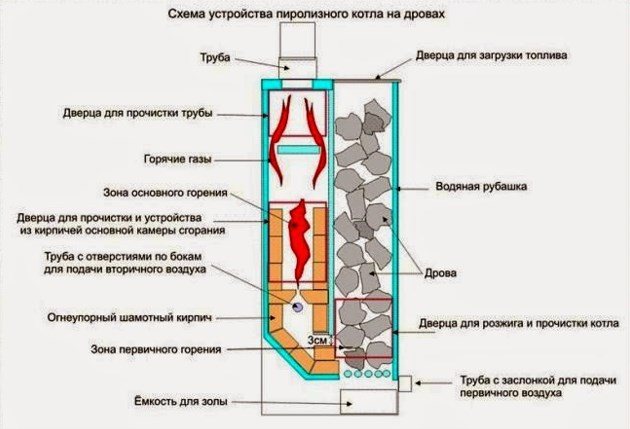

Pyrolysis heating equipment has a rather complex design, requires fuel of a strictly defined quality (humidity no more than 25%) and is volatile (the operation of fans, smoke exhausters and automation requires electricity). In addition, such devices are quite expensive and (as a rule) large in size, which affects the size of the boiler room for a solid fuel boiler. Pyrolysis plants of the VERNER and ATMOS trademarks have found wide application in the homes of our compatriots.
Solid fuel pyrolysis boilers
To optimize fuel consumption and increase efficiency, pyrolysis home heating boilers for solid fuel have been developed. Despite the similarity of the processes taking place inside the structure, their principle of operation differs from the described models of direct combustion.
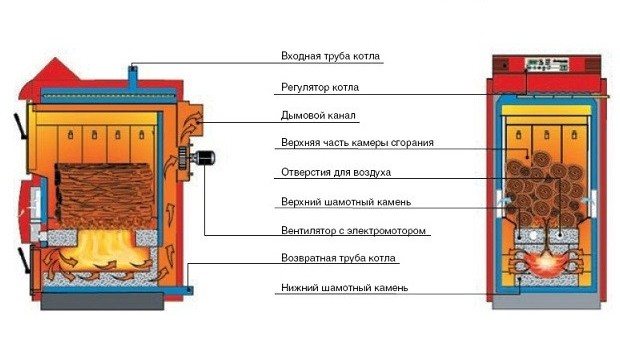

Pyrolysis boiler design
Similar solid fuel boilers for hot water supply are also called gas-fired boilers. Their principle of operation is not based on direct combustion of firewood, but on the formation of a volatile mixture. With a relatively small temperature effect on the wood and with a minimum flow of oxygen, the process of their smoldering occurs. As a result, the so-called wood gas is formed. Rising through special channels, it enters the combustion chamber, where it mixes with the air flow and ignites.
The advantage of operating gas-fired heating boilers for a house on solid fuels is economical fuel consumption. On average, one batch of firewood is enough for 12-18 hours of work. In addition, pyrolysis cast iron boilers for solid fuel heat supply are characterized by the following qualities:
- Electrical connection... For efficient operation, the boiler must be equipped with a fan or turbine (rare);
- Fuel quality... Before loading, the wood must go through a drying stage. The optimum humidity for heating a private cottage with solid fuel should be 8-10%;
- Minimum volume of carbon monoxide... Most of them are burned in the secondary chamber. Due to this, when calculating a solid fuel boiler, it is possible to provide for a chimney with a smaller diameter. But it must be insulated, since there is a high probability of condensation on its surface;
- Fuel types... The device of a solid fuel pyrolysis boiler is made in such a way that logs, sawdust and wood waste can be used. It is important that they have the right level of humidity and do not contain foreign impurities.
To regulate the power of do-it-yourself solid fuel heating boilers, you can connect a fan to the control unit. It will adjust the power of the device depending on the indoor and outdoor temperature. Thus, you can reduce fuel consumption and optimize heating performance.
It is possible to improve the characteristics of a home-made gas-generating solid fuel heating boiler by lining its outer surface. This will reduce the heat loss of the structure.
Heat generator device AC-Burners
|
| The device and principle of operation of the heat generator AC-Burners |
The lineup
The AC-Burners range is represented by 7 models of automatic charging devices and 15 models of heat generators.
| Heat generator HOT 15 | Heat generators HOT 30-55 | Heat generators HOT 120-175 |
| Model | Unit rev. | HOT 15 | HOT 30 / ECO | HOT 55 / ECO | HOT 85 / ECO | HOT 120 / ECO | HOT 175 / ECO | HOT 240 / ECO | HOT 350 / ECO |
| Thermal power | KW | 14,9 | 29,8 | 49,8 | 85,0 | 115,0 | 174,5 | 233,5 | 407,0 |
| kcal / h | 12 800 | 25 700 | 42 900 | 73 000 | 99 000 | 150 000 | 190 000 | 350 000 | |
| Nominal air flow | m 3 | 1 000 | 2 200 | 6 000 | 6 400 | 7 200 | 12 800 | 14 400 | 25 500 |
| Chimney | mm | 150 | 200 | 200 | 200 | 200 | 220 | 220 | 250 |
| Air duct diameters | mm | 2 x 150 | 2 x 200 | 2 x 200 | 3 x 180 | 3 x 200 | 3 x 220 | 3 x 220 | 4 x 300 |
| Heated volume | m 3 | 800 | 1 500 | 2 000 | 2 350 | 2 700 | 3 000 | 3 500 | 5 200 |
| Electric motor power | kw | 1 | 1/1,2 | 1,5/1,7 | 2,0/2,2 | 2,2/2,4 | 3,0/3,3 | 3,5/3,7 | 6,0/9,0 |
| Electricity voltage | V-50 Hz | 220 | 220 | 220/380 3N | 380 3N | 380 3N | 380 3N | 380 3N | 380 3N |
| Fuel consumption | kg / h | 3 | 4,8/4,2 | 8,4/7,2 | 12/10 | 16,2/14 | 24/20,6 | 31,6/28 | 54/48 |
| Dimensions, WxHxD | cm | 111x166x70 | 145x160x95 | 155x166x100 | 153x180x105 | 153x180x105 | 162x190x115 | 165x200x117 | 200x250x170 |
| Weight | Kg | 300 | 340/360 | 400/420 | 420/450 | 540/570 | 630/650 | 700/720 | 1800/2150 |
Automatic fuel supply systems
AC-Burners solid fuel heat generators can be supplied with auto-ignition and auto-fuel supply systems with different bunker capacities. Thanks to this, the equipment is able to operate in an autonomous mode, only regular ash removal from the pallet is required.
| CP series hopper | P series hopper | Bunker SB Series |
A significant difference between a heat generator and a furnace is that this device is not intended for heating rooms with the help of radiant energy - its design includes heat exchangers in which the air circulated throughout the room is heated. The efficiency of fuel combustion and the distribution of heated air throughout the room is provided by a fan that pushes the primary air into the fuel combustion chamber.
Heating of the drying and heating agent in the heat exchanger excludes the ingress of fuel combustion products into it and allows dry and heated air to be removed into the room, and gases and process wastes to be discharged into the atmosphere through the chimney. The design of generators allows you to take full advantage of a number of advantages:
- the use of biomass as a fuel, which can significantly reduce the cost of purchased fuel and use waste accumulated in production;
- high strength design, well tolerant of heat and practically does not emit radiant heat energy through the body;
- the maximum direction of the energy of fuel combustion to warm up the air supplied to the room;
- almost complete and controlled combustion of fuel due to effective blowing by a fan and arrangement of the combustion section of the generator.
Solid fuel boiler for long burning
One of the alternatives to a pyrolysis heating boiler are long-burning models. This is a relatively new heating structure, which is characterized by low fuel consumption and a long combustion period.
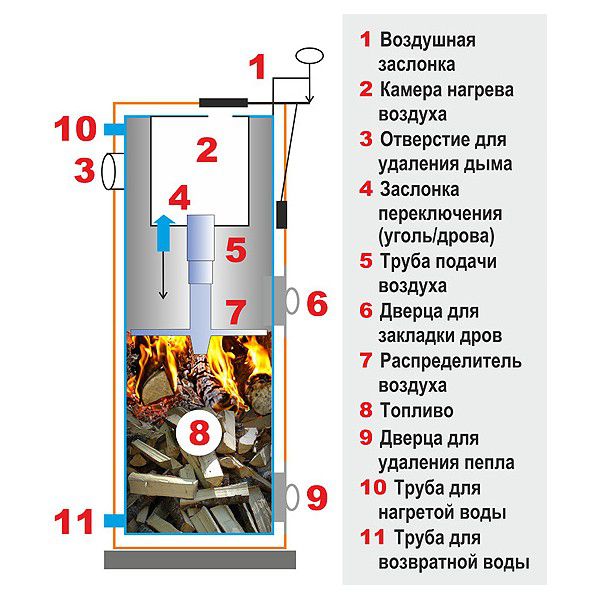

Long burning boiler
The classic scheme for installing a solid fuel heat supply boiler provides for significant heating of water in a heat exchanger. Currently, low-temperature systems are gaining great popularity. It is for such schemes that a long-burning boiler will be optimal. It differs from classical models in the absence of an ash pan and in the way of air supply to maintain the fuel combustion process. Reviews of long-burning boilers for solid fuel heating indicate their high efficiency and reliability of operation.
Structurally, it consists of a large combustion chamber that occupies about 90% of the total boiler volume. The air is supplied through the top pipe, which is lowered by gravity as the fuel burns. In fact, a smoldering process takes place, due to which the temperature of the coolant does not exceed + 70 ° C.
It will be useful for the consumer to know the following properties of a long burning boiler:
- The presence of an automatic draft regulator... This is a mechanical device that has a thermocouple in its design. When it heats up, the air flow decreases. The reverse process provokes a decrease in the temperature of exposure to the thermoelement;
- No need to connect to the mains;
- Ash removal is carried out once every 3-4 days of work... However, with a large amount of combustion products, a sharp deterioration in the operation of the boiler occurs;
- Burning occurs only at the top... This results in a significant reduction in fuel consumption.
One of the disadvantages of long-burning boilers is their high cost. However, with the correct design of the heating system, compensation for primary costs will occur after 4-5 heating seasons. It is also necessary to protect the structure from moisture.
It is necessary to control the circulation rate of the coolant. Its intense cooling can provoke moisture loss on the surface of the heat exchanger..
Installation diagram
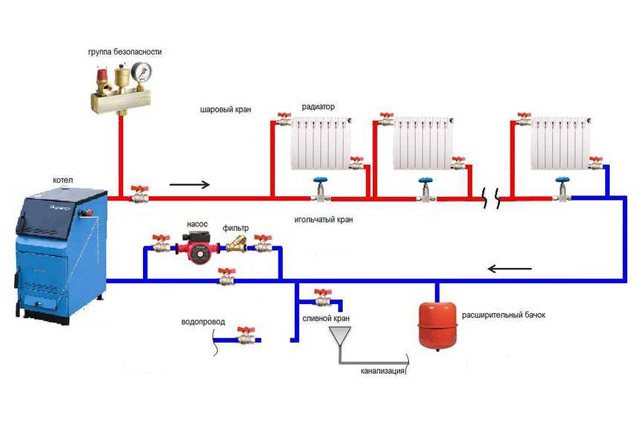

Solid fuel heating system
The installation diagram for solid fuel heating includes the following elements:
- The boiler is the main heat generator (its varieties will be discussed below).
- Storage tank - provides uniform fuel combustion, designed to compensate for the thermal expansion of the coolant.
- Thermostatic Mixer - Mixes hot and cold water to ensure an even temperature.
- Safety group - safety valve, pressure gauge, Mayevsky cock. Thanks to three devices, the heating system is protected from overpressure and airing.
- Circulation pump - moves water, excludes temperature drop when supplying water.
- Chimney - removes combustion products.
- Heating radiators, heating circuit - give off heat directly to the premises.

